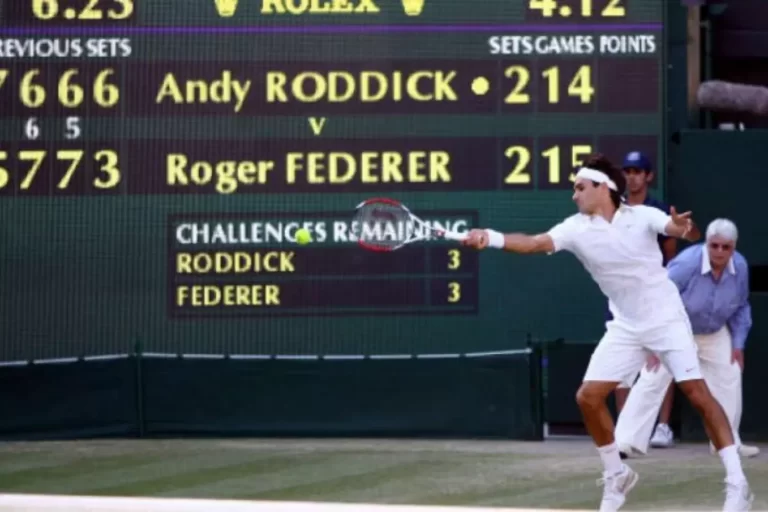How Do Tennis Tiebreakers Work?

Tennis fans have been captivated by many great matches and moments over the past decade. There was one at Wimbledon in 2010 that was particularly noteworthy.
An American named John Isner faced a Frenchman named Nicolas Mahut in the first round. Back then, Isner was ranked 19th in the world, so it should have been an easy win for him.
However, what followed was one of the longest tennis matches ever played. As a result of a 70:68 score in the fifth set, the American finally won after eleven hours.
In 1954, the American Jimmy van Allen invented the Tiebreak to prevent these marathon matches. The Tiebreak as we know it today wasn’t invented until 1971 by Peter Johns and officially incorporated into the tennis rules.
Tiebreaks are special games played between tennis players to determine who wins a tie. The first player to score seven points in a tiebreak wins the set and the tiebreak after a set is tied at 6 games to 6. The first one to win by a 2-point margin if there is a tie at 6-points-to-6.
What Does Tiebreaker Mean In Tennis?

A tiebreaker is the most crucial part of each set, where every point counts more than in a game. A tie in a tennis match can be broken by this special game.
As a result, sets and matches can be decided more quickly, avoiding matches like the 2010 Isner-Mahut match at Wimbledon.
Tie Break in Tennis Rules
There are only a few rules. Tiebreaks are won by the first person to reach seven points (or the player who leads by two points if it is still tied 6-6).
Serving from the right side of the court in the tiebreak is the right of the player who returned serve in the last game of the set. The player with the serve changes after the first point, his first serve coming from the left side of the court.
Any time there is an uneven sum of points, the serve is changed. Then after two, three, etc. To win at least one point while the opponent serves, the winner must win at least one point. The break is referred to as a “mini-break”.
It is necessary for players to switch sides after every six points. However, they cannot sit down during this switch. The only thing they should do is to walk across the bridge and grab a quick sip of water if they need it.
You can also read What Is A Walkover In Tennis?
Tie Break in Tennis Doubles Rules
Similar to singles, the pairing that returned serve in the last game of the tiebreak first serves in the tiebreak. As the next player to serve, the opposing team will serve the following two points.
In the tie-break, teams alternate serving two consecutive points for the next two sets, starting with the first team. In an effort to improve viewer enjoyment of doubles matches, the tennis governing bodies decided to introduce a ten-point tiebreaker a few years ago.
All tournaments except Grand Slams are subject to this rule.
Ten-Point Tiebreak in Tennis

10-Point Tiebreak rules are almost similar to regular ones, with the main difference being that the first player to reach 10 points wins by a margin of two points.
As long as there is a 10:10 score, the match continues until one player leads by two points. A new side is selected after every sixth point, beginning with the first.
There is no longer a deciding set in all double competitions today; instead, a 10-point tiebreak is played. A 6:6 tie in the deciding set is resolved at the Australian Open on the singles tour.
You can also read What Is A Break Point In Tennis?
The Longest Tennis Tiebreak Ever
A Challenger Tournament in Plantation, Florida, had the longest tiebreak ever recorded in 2013. Guillaume Couillard was defeated by Benjamin Balleret in a 70-point tiebreak 7:6 (36:34), 6:1. ITF and ATP verified the match score despite the absence of line judges and chair umpires.
It happened numerous times in an ATP main draw that a men’s singles tiebreaker lasted 20:18. The 2004 Tennis Masters Cup Semi-finals in Houston featured Roger Federer and Marat Safin. After 26 minutes, Federer won the tiebreaker with a score of 20:18. You can also read about The Longest Tennis Rallies
FAQs
When was the tiebreaker system introduced in tennis?
Since the 1970s, tiebreakers have been used.
Are tiebreakers used in all sets of a tennis match?
There is no tiebreaker when a set is tied at 6-6; only when it reaches 7-7 do tiebreakers take place.
How does serving work in a tennis tiebreaker?
In a tiebreaker, players alternate serving every two points, starting with the previous game’s winner.
What is the scoring system in a tennis tiebreaker?
Tiebreakers are decided when a player reaches seven points and has at least a two-point lead over his/her opponent.
Are tiebreakers played in doubles matches?
There is a unique format for tiebreakers in doubles matches, in which each player serves twice before switching sides.
Conclusion
There are many ways in which tiebreaks have been an excellent invention. Every single point counts, which adds to the excitement. If a top player commits too many unforced errors and has a few bad moments, it can also lead to surprising results.
Moreover, it favors players who have a great serve, since getting “mini-breaks” is crucial to winning a tiebreak.
As well as keeping the games shorter, they are also essential. In a Grand Slam, players have little rest between matches and no one wants to spend eleven hours on the court.
Also, the 10-Point Tiebreak saved doubles matches from extinction. In addition to making them shorter, it also made them more enjoyable to watch.
Also, read What Is An Ace In Tennis

![Serena Williams Racket and String [Updated]](https://tennisracketnet.com/wp-content/uploads/2023/11/Serena-Williams-Racket-and-String-768x512.webp)



